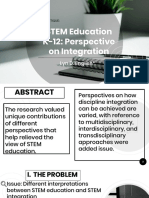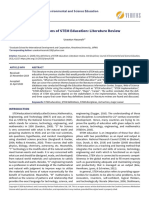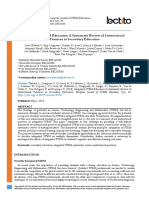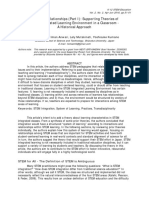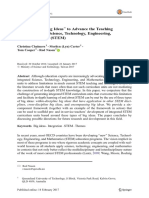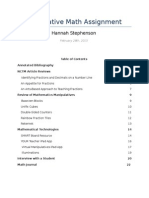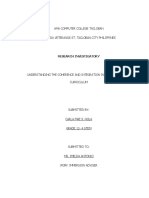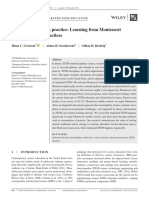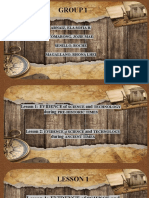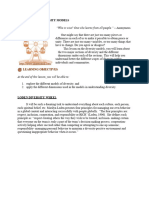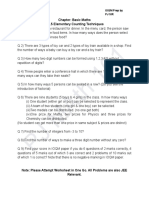Abstract
The integration of the STEM disciplines (Science, Technology, Engineering, and
Mathematics) has been a subject of debate in educational settings, with proponents
arguing for the benefits of teaching these subjects as an interdisciplinary entity and others
advocating for their continued separation. In recent years, there has been increasing
recognition of the importance of STEM education in preparing students for success in a
rapidly changing world driven by technological advancements and scientific innovation.
However, the optimal approach to delivering STEM education remains a topic of
contention among educators.
The importance behind this study lies in the growing significance of STEM education
and the need to explore effective pedagogical approaches to teaching these subjects. By
understanding the perspectives of educators regarding the integration of STEM
disciplines, this study seeks to contribute to informed decision-making in curriculum
design and instructional practices.
Problem statement:
The problem addressed in this study is whether it is better to merge the four disciplines of
STEM and teach them as an interdisciplinary entity or continue teaching science,
technology, engineering, and mathematics as separate subjects. This issue is complex and
multifaceted, involving considerations related to curriculum coherence, pedagogical
effectiveness, and student learning outcomes.
Approach:
To investigate this issue, a survey was conducted among teachers at the elementary,
middle, and high school levels. The survey gathered data on educators' preferences
1
�regarding the integration of STEM disciplines, with participants indicating whether they
favored teaching STEM as an interdisciplinary entity or maintaining separate subject
areas.
Results:
The survey results revealed varying degrees of support for merging STEM disciplines
into a cohesive entity versus maintaining them as distinct subjects across different
educational stages. In the elementary stage, three out of four teachers favored teaching
STEM as an entity, while one teacher preferred separate subjects. In the middle school
stage, five out of eight teachers supported merging STEM disciplines, while three
preferred separate subjects. At the high school level, six out of ten teachers voted for
merging STEM as one entity, with four advocating for separate subjects.
Conclusions: The findings of this study underscore the importance of considering
educators' perspectives in shaping STEM education policies and practices. While there is
no one-size-fits-all approach, the survey results suggest a trend towards favoring the
integration of STEM disciplines, particularly at the higher educational levels. However,
further research is needed to explore the effectiveness of interdisciplinary approaches in
enhancing student learning outcomes and preparing them for future challenges in STEM
fields. Ultimately, informed decision-making in curriculum design should take into
account the diverse needs and preferences of educators, as well as the overarching goal of
fostering STEM literacy and competency among students.
2
�Title: Exploring the Debate: Merging STEM Disciplines as an Interdisciplinary
Entity vs. Teaching Them Separately
Introduction:
The debate surrounding the integration of STEM (Science, Technology, Engineering,
and Mathematics) disciplines as an interdisciplinary entity versus teaching them
separately has garnered significant attention in educational discourse. Proponents of
merging STEM disciplines argue that an interdisciplinary approach fosters holistic
understanding and prepares students for real-world problem-solving (National Research
Council, 2012). On the other hand, advocates for separate subject instruction emphasize
the depth of knowledge and specialized skills gained through focused study.This essay
examines both perspectives to provide insights into the ongoing debate.
Benefits of Merging STEM Disciplines:
Merging STEM disciplines as an interdisciplinary entity offers several advantages.
Firstly, it promotes connections between various fields, mirroring the interconnected
nature of real-world problems. For instance, integrating mathematics into science
experiments or incorporating engineering principles into technology projects enhances
students' understanding of how disciplines intersect (Moore et al., 2014). This
interdisciplinary approach fosters critical thinking, creativity, and collaboration skills
essential for addressing complex challenges in today's society (National Research
Council, 2014).
3
� Furthermore, merging STEM disciplines facilitates contextual learning, allowing
students to apply theoretical concepts to practical scenarios (Dori & Belcher, 2005). For
example, integrating mathematics into environmental science lessons enables students to
analyze data and make informed decisions about sustainability issues (Wilson, 2013).
Additionally, an interdisciplinary approach encourages students to see the relevance of
STEM subjects in everyday life, fostering greater engagement and motivation (Quigley et
al., 2018).
Moreover, interdisciplinary instruction better prepares students for future careers,
which increasingly demand multidisciplinary skills (Bybee, 2013). By integrating STEM
disciplines, students develop a comprehensive skill set that aligns with the demands of a
rapidly evolving workforce (National Science Board, 2015). This approach also reflects
the interdisciplinary nature of many STEM professions, where professionals collaborate
across disciplines to innovate and solve complex problems (Honey et al., 2014).
Benefits of Teaching STEM Subjects Separately:
Despite the benefits of merging STEM disciplines, proponents of teaching them
separately argue for the importance of depth and specialization (National Research
Council, 2012). Teaching STEM subjects separately allows for a more in-depth
exploration of each discipline, ensuring that students acquire a strong foundational
knowledge base (American Association for the Advancement of Science, 2011). This
4
�depth of understanding is crucial for students pursuing advanced studies or careers in
specialized fields (National Research Council, 2012).
Furthermore, separate subject instruction allows for tailored learning experiences that
cater to students' individual interests and aptitudes. For example, students passionate
about mathematics can delve deeper into advanced topics without being constrained by
the integration of other disciplines (Wilson, 2013). Similarly, those interested in
engineering can focus on specialized projects and problem-solving techniques.
Additionally, teaching STEM subjects separately enables educators to adhere to
established standards and curriculum guidelines specific to each discipline (Bybee, 2013).
This ensures that essential concepts and skills are adequately covered, laying a solid
foundation for further academic and professional pursuits (National Research Council,
2014). Moreover, separate subject instruction facilitates the mastery of discipline-specific
terminology, methodologies, and techniques, which are essential for academic success
and career readiness (Bell, 2005).
Conclusion:
In conclusion, the debate over merging STEM disciplines as an interdisciplinary entity
versus teaching them separately encompasses various perspectives and considerations.
While merging disciplines offers benefits such as fostering interdisciplinary connections,
contextual learning, and preparation for future careers, teaching STEM subjects
separately allows for depth, specialization, and tailored learning experiences. Ultimately,
5
�the optimal approach may vary depending on educational contexts, student needs, and
learning objectives. Therefore, educators and policymakers must carefully weigh the
advantages and challenges of each approach to make informed decisions that best serve
the interests of students and society as a whole.
6
�References
American Association for the Advancement of Science. (2011). Vision and change in
undergraduate biology education: A call to action. Retrieved from
https://visionandchange.org/
Bell, T. (2005). The impact of contextualized curriculum reform on student attitudes
towards science learning. Research in Science & Technological Education, 23(3),
283-301. doi:10.1080/02635140500142800
Bybee, R. W. (2013). The case for STEM education: Challenges and opportunities.
Arlington, VA: National Science Teachers Association.
Dori, Y. J., & Belcher, J. (2005). How does technology-enabled active learning affect
undergraduate students’ understanding of electromagnetism concepts? The
Journal of the Learning Sciences, 14(2), 243-279.
doi:10.1207/s15327809jls1402_3
Honey, M., Pearson, G., & Schweingruber, H. (Eds.). (2014). STEM integration in K-12
education: Status, prospects, and an agenda for research. Washington, DC:
National Academies Press.
Moore, T. J., Glancy, A. W., Tank, K. M., Kersten, J. A., Smith, K. A., & Stohlmann, M.
S. (2014). A framework for quality K-12 engineering education: Research and
development. Journal of Pre-College Engineering Education Research (J-PEER),
4(1), 1-13. doi:10.7771/2157-9288.1099
7
�National Academies of Sciences, Engineering, and Medicine. (2014). STEM integration
in K-12 education: Status, prospects, and an agenda for research. Washington,
DC: National Academies Press.
National Research Council. (2012). A framework for K-12 science education: Practices,
crosscutting concepts, and core ideas. Washington, DC: National Academies
Press.
National Research Council. (2014). STEM learning is everywhere: Summary of a
convocation on building learning systems. Washington, DC: National Academies
Press.
National Science Board. (2015). Revisiting the STEM workforce: A companion to
science and engineering indicators 2014. Arlington, VA: National Science
Foundation.
Quigley, C., Herro, D., & Jamil, F. M. (2018). Connecting STEM curriculum and
instruction to learners’ futures: 8 essential elements. New York, NY: Routledge.
Wilson, S. (2013). Educational reform: The role of teachers and teacher educators. In J.
Hattie & E. M. Anderman (Eds.), International guide to student achievement (pp.
489-491). New York, NY: Routledge.













